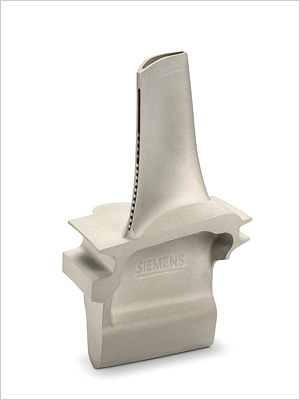Siemens achieves breakthrough with 3D printed gas turbine blades
Siemens has achieved a breakthrough by finishing its first full load engine tests for gas turbine blades completely produced using Additive Manufacturing (AM) technology. The company successfully validated multiple AM printed turbine blades with a conventional blade design at full engine conditions. This means the components were tested at 13,000 revolutions per minute and temperatures beyond 1,250 degrees Celsius.

Furthermore, Siemens tested a new blade design with a completely revised and improved internal cooling geometry manufactured using the AM technology. The project team used blades manufactured at its 3D printing facility at Materials Solutions, the newly acquired company in Worcester, UK. Materials Solutions specializes in high performance parts for high temperature applications in turbomachinery where accuracy, surface finish and the materials quality is critical to ensure operational performance of the parts in service. The tests were conducted at the Siemens testing facility in the industrial gas turbine factory in Lincoln, UK.
“This is a breakthrough success for the use of Additive Manufacturing in the power generation field, which is one of the most challenging applications for this technology,” said Willi Meixner, CEO of the Siemens Power and Gas Division. “Additive Manufacturing is one of our main pillars in our digitalization strategy. The successful tests were the result of a dedicated international project team with contributions from Siemens engineers in Finspång, Lincoln and Berlin together with experts from Materials Solutions. In just 18 months they completed the entire chain from component design and AM material development to new methods for lifing simulations and quality controls. With our combined know-how in 3D printing, we will continue to drive the technological development and application in this field,” added Meixner.
The blades were installed in a Siemens SGT-400 industrial gas turbine with a capacity of 13 megawatts (MW). The AM turbine blades are made out of a powder of high performing polycrystalline nickel superalloy, allowing them to endure high pressure, hot temperatures and the rotational forces of the turbine’s high speed operation. At full load each of these turbine blades is travelling at over 1,600 km/h, carrying 11 tons or equivalent to a fully loaded London bus, is surrounded by gas at 1,250 °C and cooled by air at over 400 °C. The advanced blade design tested in Lincoln provides improved cooling features that can increase overall efficiency of the Siemens gas turbines.
Additive Manufacturing is a process that builds parts layer-by-layer from sliced CAD models to form solid objects. Also known as ‘3D printing’ it especially provides benefits in rapid prototyping. “This exciting technology is changing the way we manufacture by reducing the lead time for prototype development up to 90 percent,” said Meixner. “Siemens is a pioneer in Additive Manufacturing. We can accelerate the development of new gas turbine designs with an increased efficiency and availability and can bring these advancements faster to our customers. This new flexibility in manufacturing also allows Siemens to develop closer to the customer’s requirements and also to provide spare parts on demand.”
Siemens has a broad knowledge in essential areas like materials sciences, automation, manufacturing and process know how and is thus in a great position to shape the future in the 3D printing industry. The successful test of the advanced blade design is the next step in order to use the full potential of AM. Siemens is developing unique gas turbine designs which are only possible with AM and extends its serial production for printed turbine equipment. With an experience of more than 100 years in the energy market, Siemens converts the new design possibilities to specific solutions for its customers.
Siemens extensively uses AM technology for rapid prototyping and has already introduced serial production solutions for components in the gas turbines’ compressor and combustion system. In February 2016 Siemens opened a new production facility for 3D printed components in Finspång, Sweden. The first 3D printed component for a Siemens heavy-duty gas turbine is in commercial operation since July 2016.
Image: Siemens finished its first full load engine tests for conventional and completely new designed gas turbine blades produced using Additive Manufacturing technology (Photo: Siemens)
